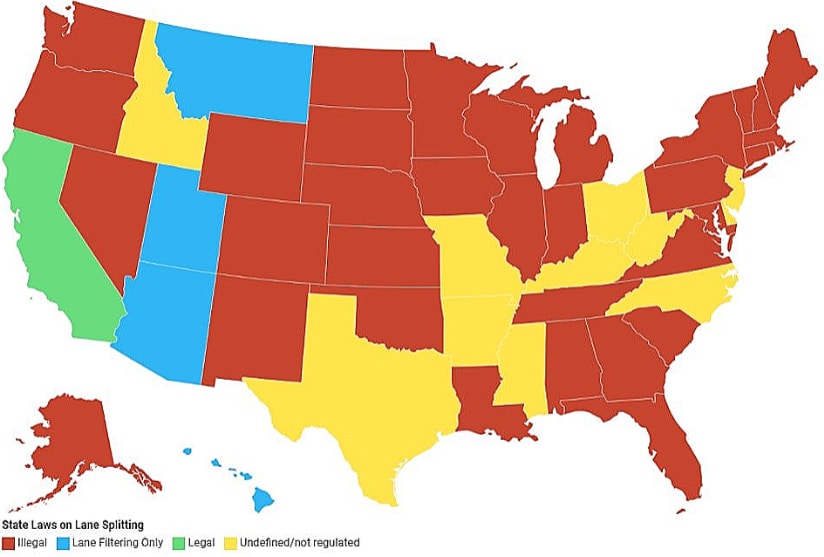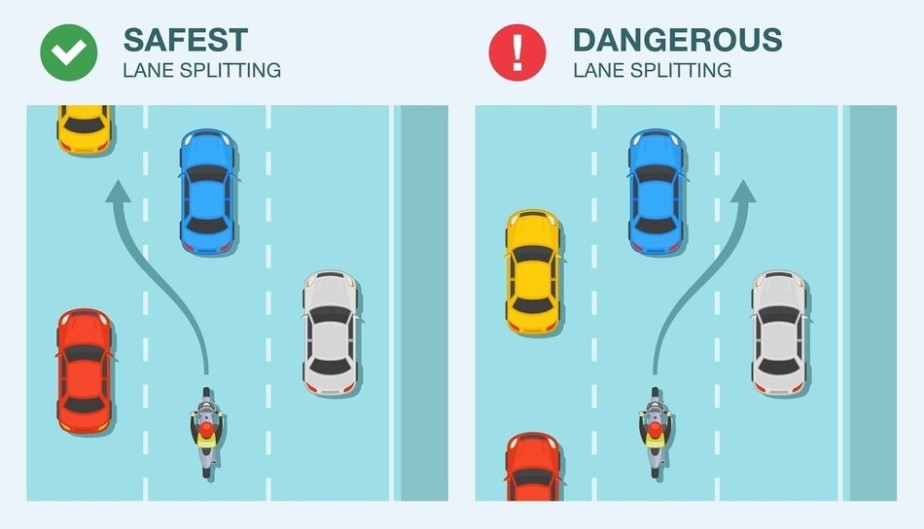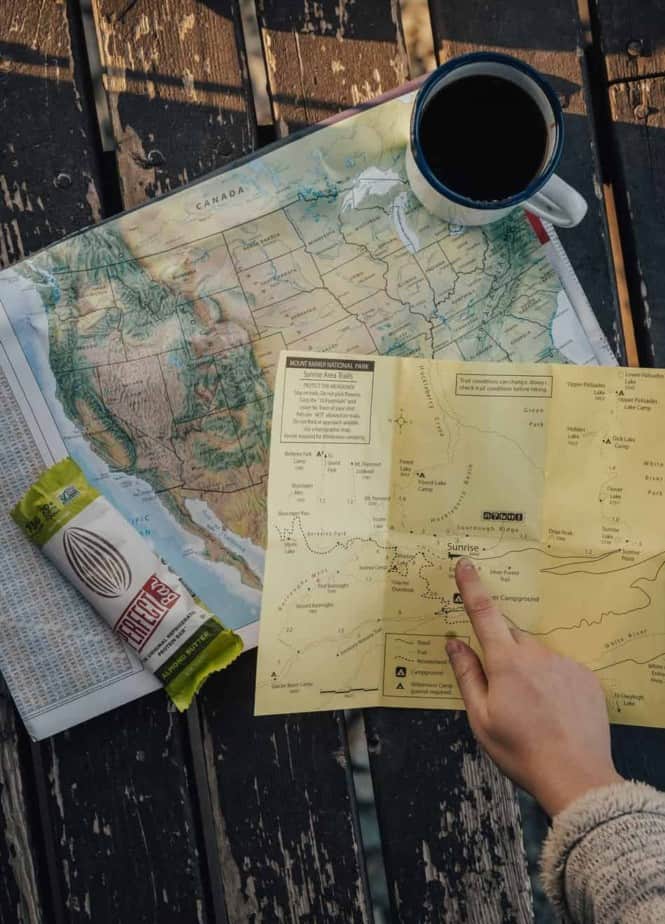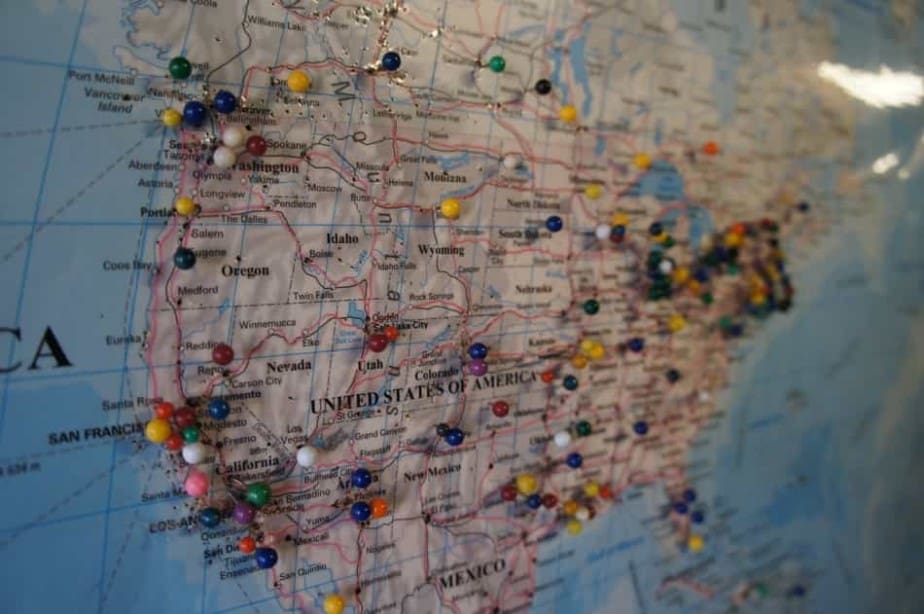
Whether you’re getting your first motorcycle license or planning a trip to a bucket-list destination, knowing local motorcycle laws is essential before hitting the open road. Lane splitting is a common but contentious practice among motorcycle riders.
While some argue that it is safer for riders, others argue that it is more dangerous than staying in a lane when traffic slows or stops. Lane splitting laws differ from state to state. Only one state expressly permits it, and only four other states have passed legislation allowing lane filtering, a modified version of lane splitting.
Lane splitting is explicitly illegal in most states and can result in not only a ticket but also being held liable in the event of an accident. A few states have taken no action against the practice. Before you take your next ride, here’s what you should know.
Table of Contents
What Is Lane Splitting?
So what is lane splitting? Lane splitting is the practice of riding a motorcycle among marked traffic lanes in the same direction. This is different from lane filtering or riding between rows of stopped traffic in order to reach the intersection’s head.
Typically, lane filtering occurs at traffic lights to allow riders to safely navigate to the front of the line and prevent being sandwiched by other vehicles.
Is Lane Splitting Legal?

In the United States, lane splitting has a complicated and confusing legal status. Many motorcyclists, including some cyclists, are unaware of when lane splitting is permitted or how it differs from lane filtering.
A survey in 2012 found that 53% of non-motorcycle drivers believed it was legal to split lanes, despite the fact that California traffic law did not address lane splitting at the time.
Lane splitting is either illegal or not specifically mentioned, or prohibited in most states. Only a few states have made lane splitting legal, but a few are considering legislation or allowing different versions such as lane sharing or lane filtering.
Where Is Lane Splitting Legal?

Only one state allows lane splitting, but three others allow a modified version. Lane splitting is either explicitly illegal or unregulated in other states, with no state statutes specifically addressing the practice.
Is Lane Splitting Legal in My State?
These states either permit lane splitting or make some variation of it legal, such as lane filtering.
Arizona-Lane Filtering in Arizona Under Certain Conditions
Planning an Arizona motorcycle tour, such as a Grand Canyon tour? It is one of the most recent states to legalize lane splitting. In 2022, Arizona became the fourth state to make motorcycle lane filtering legal.
SB 1273, Arizona’s new lane splitting law, is very limited, but it allows motorcycle riders to ride between lanes of stopped traffic at a traffic light. The law is intended to protect motorcyclists from being rear-ended or becoming trapped between two cars when traffic comes to a halt.
In Arizona, lane filtering is only permitted when:
- The speed limit on the road is 45mph or less, and the motorcyclist does not exceed 15mph.
- The street is divided into two or more lanes that travel in the same direction.
- The rider is passing a stopped vehicle in the same lane, and the rider is passing between lanes of traffic rather than on the median or shoulder.
California
Lane splitting is legal in only one state: California. The other three states on this list only permit lane filtering under certain conditions. Lane splitting was never illegal in California, but AB 51 was signed into law, making it officially legal and sanctioned.
Motorcyclists should not exceed 10mph above the flow of traffic when splitting lanes. Motorcyclists are discouraged from splitting lanes when traffic speeds exceed 30 miles per hour. Lane splitting is not permitted near freeway on-ramps and exits.
The California Highway Patrol provides motorcycle lane splitting safety tips.
Hawaii
Shoulder surfing is permitted in some conditions. Hawaii is known for its beautiful rides and its very narrow roads, making lane splitting and traditional lane filtering less than preferred even if allowed. Hawaii enacted a new law in 2018 that allows shoulder surfing as an alternative to lane filtering.
Motorcyclists may use the road shoulders to pass stopped traffic in approved areas. In Hawaii, shoulder riding is only permitted on roads with a minimum of two lanes in each direction and a shoulder lane wide enough to accommodate the vehicle safely. This can only be used to pass through stopped traffic.
Montana
Montana became the third state to legalize some form of lane splitting in 2021. Montana Senate Bill 9 took effect in October 2021 and allows motorcycle riders to split lanes to overtake stopped or slow vehicles if:
- The motorcyclist does not exceed 20mph.
- The lanes are wide enough.
- The traffic and road conditions are safe.
- The motorcyclist maintains a speed of no more than 10 mph while splitting lanes.
Lane filtering or overtaking stopped or slow traffic traveling no faster than 10mph in the same direction is specifically permitted in Montana. Lane splitting is not permitted otherwise.
Utah
After California, Utah was the first state to legalize some form of lane splitting. The Utah lane filtering law, which was passed in 2019, allows motorcycles to move between stopped traffic lanes. Lane filtering is only permitted when the following conditions are met:
- The speed limit is 45mph or fewer
- The motorcycle rider is not going over than 15mph when filtering
- The road has at least 2 lanes heading in the same direction
- The motorcycle rider filters among marked lanes, not on the shoulder or a bike lane
- Traffic is stopped
States that Do Not Have Lane-Splitting Laws

If you’re riding a motorcycle in one of these states, you need to be aware that even if the law doesn’t specifically prohibit lane splitting or lane filtering, you could still face a citation. You could be ticketed for making an improper lane change, failing to maintain a lane, or even driving recklessly.
If you cause an accident while splitting or filtering lanes, you could be held partially or fully liable (depending on what state) because the practice isn’t explicitly permitted or violates other traffic laws.
Arkansas
Vehicles must drive “as nearly as practically completely within a single lane” and stay in the lane unless it is otherwise safe to move outside the lane, according to Arkansas Code 27-51-302.
Is it legal to split lanes in Arkansas? Lane splitting is de facto legal since there is no mention of it in the vehicle code and because this vague vehicle code technically allows vehicles to drive outside the lane when it is safe. Arkansas allows two motorcycles to ride side by side along the same lane.
Delaware
There are no laws in Delaware that discuss lane splitting. While it is practically legal, it is not expressly permitted, and you may be cited for other traffic violations as a result.
District of Columbia (Washington, DC)
In Washington, D.C., lane splitting is not prohibited, but it is also not permitted. In Washington, D.C., there are no laws regarding lane splitting.
Idaho
Vehicles should travel “as nearly as reasonably possible completely inside a single lane,” according to Idaho Statutes 49-637, which is imprecise and does not bring up lane splitting. Nevertheless, you should be aware that “lane splitting is not legal in Idaho,” according to the Idaho Rules of the Road handbook for motorcycle riders.
Kentucky
Lane splitting is neither clearly legal nor illegal in Kentucky. Lane splitting and filtering are not mentioned in Kentucky statutes.
Mississippi
In Mississippi, legislation to legalize lane splitting, as well as lane filtering, was presented, but it ended up dead in committee in 2016.
Missouri
In Missouri, lane splitting is neither legal nor illegal. Because the law does not discuss riding a motorbike between traffic lanes or vehicles, it is up to law enforcement to decide whether or not to issue a citation for a connected shifting violation.
New Jersey
In New Jersey, lane splitting is neither illegal nor lawful. The New Jersey driver’s manual, on the other hand, warns against lane sharing and advises against “riding in between rows of stopped cars.”
North Carolina
Is it legal to split lanes in North Carolina? Lane splitting is not encouraged in North Carolina, but it is also not prohibited. Moreover, the practice, like lane sharing, is discouraged.
Ohio
Is it legal to split lanes in Ohio? It isn’t exactly forbidden. Although Ohio law does not specifically prohibit lane splitting or filtering, doing so can result in a ticket for a related offense such as failure to maintain a lane or to make an inappropriate lane change.
When passing stopped or slowed traffic, Ohio legislation requires motorcycle riders to practice “due care.” Because of the ambiguous language, an officer or an insurance company can interpret it how they want.
Texas
On the road with two or more labeled lanes, Texas Transportation Code 545.060 demands motorcyclists to ride “as nearly as practicably completely inside a single lane” and only relocate from the lane when “the motion can be completed securely.”
Although there is some leeway in this law, and lane splitting is frequent in Texas, it can quickly lead to a traffic offense for failing to keep a single lane.
West Virginia
In West Virginia, lane splitting is not specifically prohibited. With a vague demand that vehicles be operated “as nearly as reasonably possible completely inside a single lane,” West Virginia Code 17C-7-9 is nearly identical to other states on this list.
Where Lane Splitting Is Illegal

Lane splitting is expressly prohibited in these states.
Alabama
Lane splitting is prohibited in Alabama under Alabama Code Section 32-5A-242. Operating a motorbike “between traffic lanes or adjacent lines or rows of vehicles” is illegal under this law.
Lane sharing is permitted with no more than two motorcycles per lane.
Alaska
Lane splitting is made illegal in Alaska by AAC 02.427, which prohibits motorbikes from overtaking or passing vehicles in the same lane or driving among lines or traffic or lanes of vehicles.
Motorcycles can share lanes up to two abreast.
Colorado
Although lane splitting is prohibited in Colorado, the Colorado State Patrol reminds riders that sharing a lane or riding alongside another motorcycle is permitted.
Connecticut
Motorcyclists are prohibited from overtaking or passing any vehicle other than a motorcycle in the same traffic lane or “operating a motorcycle among lanes of traffic” under Connecticut Code Section 14-289b.
In 2019, legislation to allow lane splitting died in committee.
Florida
Florida is a popular destination for motorcycle riders from all over the nation. If you’re planning on taking some of Florida’s best motorcycle rides or riding into the state for Bike Week or Biketoberfest, make sure you’re familiar with the state’s lane splitting laws.
In Florida, lane splitting is prohibited by Florida Statute 316.20. Operating a motorcycle “between the lanes of traffic or rows of vehicles or adjacent lines ” is illegal under this law.
Georgia
Is it legal to split lanes in Georgia? Georgia, like many other states, expressly prohibits lane splitting and lane filtering under Georgia Code Section 40-6-312. It is legal to ride two motorcycles side by side in a single lane.
Illinois
Is it legal in Illinois to split lanes? Unfortunately, lane splitting is prohibited in Illinois under 625 ILCS 5/11-703. Unless there is an unobstructed lane to use, motorcycles are not permitted to pass a vehicle on the left side; when doing this will pass another vehicle on the right, moving in the same direction.
Iowa
In Iowa, lane splitting is prohibited. Operating a motorcycle between adjacent rows or lines of vehicles or traffic lanes is expressly prohibited by law. A lane may be shared between two motorcycles.
Kansas
In Kansas, lane splitting is prohibited. Motorcycles are not allowed to pass or overtake a vehicle in the same lane, ride between traffic lanes, or ride among adjacent rows or lines of vehicles, according to the law. In Kansas, up to two motorcycles can ride side by side in a lane.
Louisiana
In Louisiana, lane splitting is prohibited. Motorcycles are not allowed to be operated between traffic lanes or adjacent rows or lines of vehicles, according to LA RS 32:191.1. Motorcycles can ride side by side in lanes with up to two other motorcycles.
Maine
Lane splitting is prohibited in Maine under Title 29-A 2062 of the Maine Statutes. It is expressly forbidden to ride a motorcycle between traffic lanes, lines, or rows of vehicles. A lane can be shared by two motorcycles.
Maryland
In Maryland, lane splitting is prohibited by Maryland statute 21–1303, which restricts riding among traffic lanes and rows of vehicles. A lane can be shared by up to two motorcycles.
Massachusetts
In Massachusetts, lane splitting is prohibited. According to Massachusetts law, each vehicle must operate entirely within one lane of traffic and move in a single file using an unoccupied lane.
In 2017, legislation was introduced in Massachusetts to finally make lane splitting lawful. In 2018, a study into security concerns was ordered, but progress has slowed. The bill, which is still being debated in the Joint Committee on Transportation, would enable lane filtering in the left access lane, right breakdown lane, or lane splitting to get around slow traffic. At 25 mph or less, motorcycles would be limited to lane splitting and filtering maneuvers.
Michigan
Motorcyclists are prohibited from passing between lanes of traffic under Michigan Vehicle Code Section 257.660. Only move into an unoccupied lane of traffic to pass other vehicles. Motorcycles riding two abreast in a lane are permitted.
Minnesota
Side-by-side lane sharing is legal in Minnesota, but lane splitting is not. Riding between lanes of traffic or rows of vehicles is expressly forbidden for motorcycles. You can find details here at the Office of Traffic Safety.
Nebraska
In Nebraska, lane splitting is prohibited. Operating a motorcycle between traffic lanes, rows, or lines of vehicles is illegal.
Nevada
Are you planning a motorcycle trip to Vegas or just passing through? NRS 486.351, which prohibits passing another vehicle within the same lane or between vehicles, makes lane splitting illegal in Nevada. It is legal to ride two motorcycles side by side in a lane.
New Hampshire
Are you going to Laconia Motorcycle Week or a ride in New Hampshire? Lane splitting is prohibited in New Hampshire under NH 265:121. Motorcycles can travel up to two abreast in a lane.
New Mexico
Lane splitting is prohibited in New Mexico under Section 10.04.086B of the New Mexico Code of Ordinances. This law makes it illegal to pass in the same lane or ride a motorcycle between rows of stopped vehicles or traffic lanes.
New York
Is it legal to split lanes in New York? Lane splitting is illegal in New York under VAT 1252, despite the fact that it is a common practice. In New York, “driving between lanes” is a two-point offense.
North Dakota
Lane splitting is expressly prohibited in North Dakota, as the law says that vehicles may not be managed in such a way that other vehicles are deprived of their full lane usage.
Oklahoma
By prohibiting passing other vehicles between lanes moving in the same direction, Oklahoma Statute 47-11-1103 makes lane splitting illegal.
Oregon
Lane splitting is expressly prohibited in Oregon by ORS 814.240. Motorcycle passing is illegal in the state if:
- Overtaking or passing another vehicle in the same lane, unless it is a motorcycle or moped.
- Riding a motorcycle between lanes of traffic or adjacent rows of vehicles or lines.
After years of effort, a law allowing lane splitting was passed. Despite bipartisan support and hundreds of letters of testimony, Oregon Governor Kate Brown vetoed the bill. SB 574 would have permitted motorcycle riders to split lanes on multi-lane interstates with speed restrictions of at least 50 mph, but only if traffic was slowed to 10 miles per hour or less than that.
Pennsylvania
Is lane splitting permitted in Pennsylvania? Lane splitting is illegal in Pennsylvania, despite the fact that it is very common among motorcycle riders. Riding between lanes of moving or stopped traffic is prohibited by the PennDOT Motorcycle Operator Manual.
Rhode Island
In Rhode Island, lane splitting is prohibited. It is illegal for motorcycles to ride between traffic lanes, lines, or rows of vehicles.
South Carolina
In South Carolina, lane splitting is prohibited. Operating a motorcycle between lanes of traffic or rows of vehicles is an offense.
South Dakota
Are you planning a visit to Sturgis? Lane splitting is not permitted in South Dakota. It is legal to ride in a lane with up to two motorcycles riding side by side.
Tennessee
Is it legal to split lanes in Tennessee? While some states are ambiguous and don’t mention lane splitting, Tennessee explicitly prohibits it. Motorcyclists are not allowed to ride between lanes of traffic, rows, or lines of vehicles, according to Tennessee Code 55-8-182. In a single lane, up to two motorcycles can ride side by side.
Vermont
In Vermont, lane splitting (riding a motorcycle between traffic lanes and rows of vehicles) is prohibited. A lane can be shared by up to two motorcycles.
Virginia
Lane splitting and filtering are currently prohibited in Virginia, but motorcycles are permitted to share two-abroad lanes.
Lane filtering is being considered in Virginia for the 2022 session. House Bill 838 in Virginia would be similar to Arizona and Utah’s lane filtering laws, but it would enable motorcyclists to filter if traffic is slowed or stopped.
Washington
Motorcycles have the right to use full lanes and can ride two abreast in a lane, according to Washington’s Revised Code (RCW) 46.61.608. It expressly prohibits:
- Between lanes of traffic or between adjacent lines or rows of vehicles on a motorcycle
- Riding motorbikes more than two abreast in a lane.
In Washington State, legislators attempted to legalize lane splitting in 2017 as well as motorcycle shoulder riding in 2015, but both attempts failed.
Wisconsin
Wisconsin prohibits white lining and lane splitting. A single traffic lane must be used by all vehicles.
Wyoming
In Wyoming, lane splitting is prohibited. Passing another vehicle in the same lane, unless it is another motorcycle, and operating a motorcycle between traffic lanes or rows of vehicles are both prohibited by Wyoming Statute 31-5-115.
Wyoming is unique in that it allows motorcycles to travel in lanes up to three abreast. In most states, only two motorcycles are allowed to share a lane. In Wyoming, passing another bike in the same lane is also permitted.
Lane Splitting FAQ

Find out if lane filtering, sharing, or splitting is legitimate in your state or where you intend to ride your motorbike!
Is it legal to split lanes in Arizona?
Lane splitting is not permitted under the new Arizona lane splitting law, but lane filtering is permitted under certain circumstances. When traffic is stopped at a stoplight on the road with a speed limit of 45 mph or less, motorcycles can filter lanes.
Is it legal to split lanes in California?
Yes, California is the only state where lane splitting is clearly permitted! Although the California lane splitting legislation was passed in 2016, the practice has never been prohibited in the state.
Is it legal to split lanes in Florida?
No, Florida legislation explicitly forbids lane splitting.
Is it legal to split lanes in Texas?
Texas is one of only a few states that does not have a lane splitting law. It is neither legal nor unlawful. You could still be ticketed for a moving violation like failing to keep your lane.
Is it legal to split lanes in Oregon?
Lane splitting is not permitted in Oregon. In 2021, the governor vetoed a bill that would have allowed lane filtering or splitting in certain circumstances.
Conclusion
Although this article is pretty big, I wanted to get you familiar with laws in all the states and give you the best information possible.
